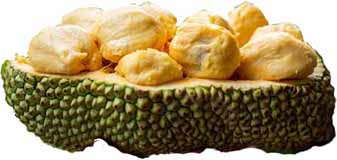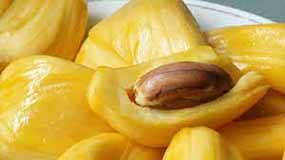There are varieties of local fruits found in Malaysia. Some of them come in all year round and some come in seasons. Malaysian fruits are abundance when the fruits seasons come. You can easily find local fruits in Malaysia. These fruits are also sell in stalls along the roadsides and trunk roads of Malaysia, fruits stores, wet markets, shops, mini markets, hyper markets, morning markets, night markets, and so on. Fruits here are abundance, cheap and delicious.
They are found in varieties of colours and shapes. You can find the delicious mouth watering fruits with skin colours of yellow, green, red, purple, black, orange, brown, etc. Those fruits are not only round or oval in shapes, but they are also found in the shapes like long cylindrical, star, sharp thorny, soft thorny, etc. They can be juicy, sweet, sour, crispy, soft, fragrant, etc. You can try out.
A trip to Malaysia would not be a complete one if one have not tried the sweet, juicy and mouth watering local fruits. Want to try the sour fruits in Malaysia? There are plenty as well. Want to challenge with the taste of Malaysia fruits? Take durian as your opponent, you will find a strong opponent for challenging your taste bug. You may be over powered by this fruit. Durian is known as the king of fruits in Malaysia.
Discover Malaysia fruits now yourself! They are irresistible.
 |
|
Guava is divided into 2 types: with seeds and seedless. It is popular for its musky aroma, soft and delicious pulp. It has a thin greenish-yellow skin and a flesh of varying thickness which may be white or pinkish red colour. It is popular eaten in raw where it is dipped into a sweet-sour powder. It is also popularly consumed in juice, ice cream, marmalade and jam. One may cut and eat the fruit with or without the skin. You may even just bite the fruit and eat!
Pink guava is characterized by its bright yellow skin and pink flesh. White Guava has more sugar, starch, Vitamin C and more seed. White guava has more Vitamin C when compared to any other fruit. Pink Guava has more water content, less sugar, less starch content, less seed or even seedless.
|
 |
| Honeydew is round to slightly oval, ranging from approximate 6 to 9 inches in diameter. Most of the honeydew rinds are extremely smooth with no netting or ribs. Some soft hairs can be seen on the surface in the early stages. The rind colour is greenish white when immature and turns creamy yellow when ripe. The flesh is light green or light creamy yellow, thick, juicy and sweet. Cut open the honeydew and slice it into smaller slices with a knife. Scrape off the seeds before eating. |
| |
 |
|
Kuinin has a strong smell but it is not unpleasant. It is the same botanical family with mango fruit and the shape is closely similar to the mango fruit. The flesh has a light orange colour and is juicy sweet. Peel off the skin with a knife and cut the flesh, there will be a big hard seed inside.
The tree flowers have a pleasant fragrance. The fruits are round or oblong in shape and have a skin that ranges from yellow-green.
|
 |
|
Longan is also known as Mata Kucing in Malay. They are covered in pale brownish skin which is rough and tough, but not hard. The flesh is translucent, whitish and sweet. The thickness of the flesh is vary. In good variety, it may be 0.5 cm thick. Lightly squeeze open the skin of the fruit with your thumb and index finger.
|
 |
|
Mango, which the local people called it "mangga". When it is still young, it is greenish in colour and when it is ripe, the colour turns yellowish. Eat the same way as Kuinin. You even can peel off the skin with your fingers if you don't have a knife. There are many types of mangos in Malaysia. Some sweet and some sour (even they are ripe). Look for the type that suits your taste bud, you will enjoy it.
|
 |
|
Mangosteen is a season fruit. The shape of a mangosteen is like round berries with a tennis ball size (some are even bigger). The outer shell is usually maroon in colour. Squeeze open the fruit between two palms, there you can see a few segments of paper white flesh, each has a seed. It is sweet and juicy. Local people normally eat mangsteen after they have eaten durian because mangosteen is said to be "cooling" to the body compared to the durian which is "heaty". It neutralizes the effect. Try out this fruit.
|
 |
|
Nangka or "Jackfruit" in English has a physical outlook which is merely the same as the cempedak fruit. But, it comes in a larger or bigger size. It also has a strong fragrant smell. The taste is exotic and most people in Malaysia like it. Cut open the fruit, you can see small yellow rounded size flesh. Be careful of the latex once you cut open the fruit, the white latex is sticky. Eat the same way as cempedak, but local people in Malaysia seldom use this fruit for "goreng" (fried). As this fruit is very large, the inner flesh normally being taken out and put in small plastic bag and sell in packets.
 
The right is nangka flesh and the left picture is cempedak flesh. The nangka flesh is solid and slightly chewy feel while the cempedak flesh is softer and creamy feel when eating.
Nangka is usually huge and oval in shape while cempedak is tubular but smaller in size, it can look slightly rounder. Both are very similar, however they were classified as different species.
Nangka’s texture is more solid, while cempedak is softer and more pulpy. The opposite applies for their smell. Cempedak have stronger, distinct smell, while Nangka have softer smell.
|
 |
| Papaya has a greenish to a yellowish colour skin . This fruit is tasty and soft. The flesh is normally yellow, orange or reddish in colour. Most people eat it fresh or chilled. But you may add some taste to the fruit by squeezing a few drops of lime or lemon juice onto the fruit. It taste fantastic. Cut open the fruit, get rid of the small seeds (there are hundreds of them) and scoop the flesh with a spoon. |
 |
|
Passion Fruit comes in two different varieties: Purple and Yellow. Purple: originating from South America, the purple passion fruit is rich in vitamin C. Passion fruit tastes tart and sweet, with a strong tropical aroma.
The seeds are easy to eat and crunchy, and the jelly-like flesh is very refreshing, and the taste can range from sour to very sweet.
|
Page 1 2 3 4













